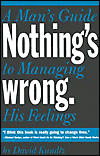
One feeling in particular merits a special note: anger. If this feeling is a problem for you, you're not alone. It seems that modern life is full of poor expressions of anger. Just listening to the news a few evenings a week proves that.
Ron and Pat Potter-Efron point out in their book Letting Go of Anger some of the ways that emotionally healthy people handle anger. The following techniques are based on their ideas. Check them out to see if they make sense to you.
- They treat anger as a normal part of life. Everybody gets angry at one time or another. All of us. It's human.
- They see that anger is an accurate signal of real problems in a person's life. So anger has its useful purpose. It alerts us to real problems.
- They screen angry actions carefully; they needn't get angry automatically just because they could. The key word here is "get." You notice you're feeling angry (first step); you name it as "anger at my boss" (second step); your third step is perhaps to wait a while and then approach your boss with the reason for your anger, rather than to "get angry" right in his face.
- Anger is expressed in moderation so there's no loss of control. People who are emotionally healthy are good at picking the right time to do the third step, and the right place, too.
- Their goal is to solve problems, not just to express anger. If the goal is to resolve whatever challenge presents itself, the temptation to wallow will be weakened. That's good.
- Their anger is clearly stated in ways others can understand. Much better to say to your friend, "I am really mad at you for telling what you promised to keep secret," than to avoid him (and hold your anger) for a month.
- They see that anger is temporary. It can be relinquished once an issue is resolved. No one is more boring and dull than someone who is "always angry." People learn to stay away.
Dealing with Anger
Here are a few suggestions for practicing the third step, when the feeling is "ANGER!"
- Recognize the signs of anger and make part of your third step a weakening of the energy by conscious breathing, counting to ten slowly, or talking over the situation with someone you trust.
- Practice a relaxation technique or take a short walk. Also useful are Asian arts such as yoga, tae kwan do, or tai chi, a series of slow, purposeful movements.
- Identify and, if possible, avoid circumstances that trigger anger. Arrange and plan your life so as to avoid what you know will make you mad. If possible, simply leave a situation that will feed your anger.
- Exercise is often a great way to do the third step if you're feeling angry. Medical specialists tell us that it is also very good for your health.
Reprinted with permission of the publisher,
Red Wheel/Weiser, LLC.
©2004. www.redwheelweiser.com
Article Source
Nothing's Wrong: A Man's Guide to Managing His Feelings
by David Kundtz.
 Written in a matteroffact, nontouchyfeely style, Nothing's Wrong helps men manage their feelings to build rich, emotional lives and find more satisfying relationships, improved health, and successful careers. Try it -- the results can be amazing. Here's a book that truly acknowledges the bewildering effects strong emotions have on men and how men can learn to deal with them. Its plain language and examples are far from the touchyfeely tone of so many other titles in this category.
Written in a matteroffact, nontouchyfeely style, Nothing's Wrong helps men manage their feelings to build rich, emotional lives and find more satisfying relationships, improved health, and successful careers. Try it -- the results can be amazing. Here's a book that truly acknowledges the bewildering effects strong emotions have on men and how men can learn to deal with them. Its plain language and examples are far from the touchyfeely tone of so many other titles in this category.
Info/Order this book. Also available as a Kindle edition.
About the Author
 David Kundtz holds graduate degrees in psychology and theology and a doctoral degree in pastoral psychology. Ordained in the 1960s, he worked as an editor and pastor until he left the ministry in 1982. He is currently a licensed family therapist and the director of Berkeley California-based Inside Track Seminars, which specializes in stress management for the helping professions. He lives in Kensington, California and Vancouver, British Columbia. Web site: www.stopping.com.
David Kundtz holds graduate degrees in psychology and theology and a doctoral degree in pastoral psychology. Ordained in the 1960s, he worked as an editor and pastor until he left the ministry in 1982. He is currently a licensed family therapist and the director of Berkeley California-based Inside Track Seminars, which specializes in stress management for the helping professions. He lives in Kensington, California and Vancouver, British Columbia. Web site: www.stopping.com.

























